Texas Railroad History - Tower 84 - Houston (Walker Ave.)
A Crossing of the San Antonio & Aransas Pass Railway, the Houston Belt &
Terminal Railroad, and the International & Great Northern Railroad

Above: John W. Barriger III
took this photo from the rear of his private rail car on April
14, 1934 as his train was leaving Houston southbound toward the Rio Grande
Valley. The view is west-northwest along Houston Belt & Terminal (HB&T)
tracks that were leased from the Gulf, Colorado & Santa Fe (GC&SF)
Railway. The steam engine in view is crossing the San Antonio & Aransas Pass
tracks adjacent to Tower 84. This photo is number ATSF174 in the collection of the
John W.
Barriger III National Railroad Library, and it includes the notation "Leaving
Houston southbound via N.O.T.&M. over GC&SF trackage (to Algoa)." Barriger's train
will soon curve farther south, passing Tower 117
and Tower 81. It will eventually join the GC&SF main line at Alvin and run southeast less than five miles to the
Tower 65 junction at Algoa where it will turn south
on St. Louis, Brownsville & Mexico (SLB&M) tracks, one of the Gulf Coast
Lines organized under the New Orleans, Texas & Mexico (NOT&M) Railway.
Below: This view of Texas & New Orleans S2 No. 70 crossing the HB&T on the SA&AP tracks at
Tower 84 is the same as in Barriger's photo above. Although the surrounding
environment has changed, the track switches and crossover remain intact. The SA&AP came under T&NO ownership in 1925. (Joe R Thompson, courtesy Railroad & Heritage Museum, Temple, Texas,
from Southern Pacific's Eastern Lines 1946 - 1996,
by David Bernstein, (c)2015, North Texas Chapter, National Railway Historical
Society)

The first railroad in Texas was the Buffalo Bayou, Brazos and Colorado
(BBB&C) line west from Harrisburg to Stafford in 1853. Shortly thereafter, the
citizens of Houston sought a railroad to connect with the BBB&C which was only
six miles to the south. This was accomplished by the Houston Tap railroad in
1856, creating the first railroad junction in Texas,
Pierce Junction. In 1858, construction continued
45 miles farther south, reaching East Columbia in 1860, a major shipping center
near the Brazos River. The railroad became known as the "Columbia Tap", a
nickname that persists today, long after its merger into the International
& Great Northern (I&GN) Railroad in 1873.
Promoted by Galveston
interests, the Gulf, Colorado & Santa Fe (GC&SF) Railway had intentionally
routed their first rail line well south of Houston as they built west from
Galveston in 1875, reaching
Brenham in 1880. They wanted to avoid any chance of
having traffic manipulated by Houston's leaders who were not averse to declaring
a "yellow fever quarantine" periodically to cause Galveston-bound freight trains
to be off-loaded at Houston instead. The GC&SF eventually decided they could not ignore
the growing Houston market, so they built 26 miles north from their main line at
Alvin to reach the city in 1883.
In 1884, the San Antonio & Aransas
Pass (SA&AP) Railway was chartered to build a line from San Antonio to
Corpus Christi. By 1887, this line and several extensive branch lines had been
built. The SA&AP soon turned its attention to Houston, completing a 46-mile line
into the city from
Wallis in 1888, crossing the Columbia Tap and GC&SF lines southeast of downtown.
In 1905, the Houston Belt & Terminal (HB&T) Railway was chartered to provide
freight and passenger switching among four railroads in Houston, one of which
was the GC&SF. The HB&T leased various tracks from its sponsoring railroads
including the GC&SF line near downtown. In the 1910-1911 timeframe, four towers
were constructed to manage HB&T crossings with major railroads. Tower 84 was the
first of these, built to manage the junction of the Columbia Tap, GC&SF and SA&AP railroads that had existed for more
than 20 years.
Tower 84 first
appears in Railroad Commission of Texas (RCT) records in the 1911 RCT Annual
Report where it is listed as an electrical interlocker at location "Houston"
with 36 functions (but no commissioning date) controlling a junction of the
SA&AP, HB&T, and
I-GN railroads. This information is repeated in subsequent
annual reports until the 1917 report, which lists it as having 34 functions, but
still no commissioning date. Finally, in the 1924 annual report, Tower 84 is
listed with 35 functions and a commissioning date of February 18, 1918. The
1925 and 1926 reports repeat this data, but the 1927 report lists 46 functions
and an authorization date of August 10, 1910. The
1928 report updates the location to
"Houston (Walker Ave.)"; presumably confusion over the large number of Houston area
interlockers (and occasional erroneous information about them in RCT annual reports)
motivated RCT to add the "Walker Ave." designation. Whatever the case, this was
apparently not the only designation used. In the book The Southern Pacific
Guide Texas and Louisiana Lines, author David Bernstein refers to Tower
84 as being at "Rusk Ave." Bernstein mentions that the functions of Tower 84
(along with those of Towers 116 and 116A) were consolidated into
Tower 117 on
June 1, 1971, and that on April 17, 1983, the functions of
Towers 81 and 84 were
transferred to HB&T's Traffic Operations Center at Houston Union Station.
Bernstein lists 1988 as the date Tower 84 was "retired", but this may
refer only to Tower 84's interlocking functions. The fate of the Tower 84
structure is unknown, but its precise
location, where the SA&AP crossed Walker Avenue, can be determined
from the 1924 Sanborn Fire Insurance Map of Houston.
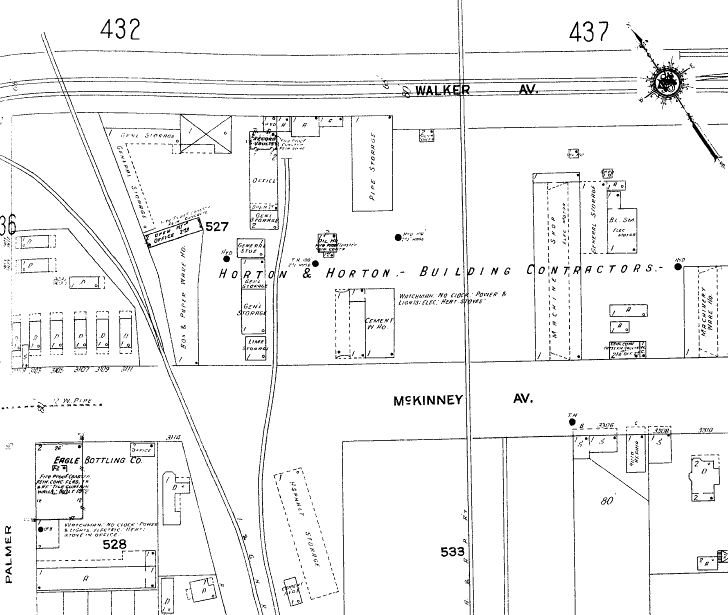
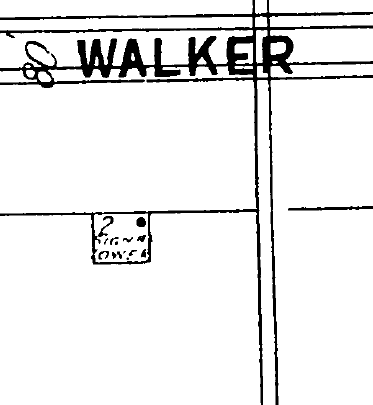
Above: The 1925 Sanborn Fire Insurance Map of Houston shows a structure located
along Walker Ave. on the west side of the diamond near a "Pipe Storage" area for
"Horton
& Horton Building Contractors". Under magnification (at right), the map reveals
the structure to be a two-story "Signal Tower".
Note that Walker Ave. was never paved at Tower 84 and appears to have hosted the
rail line, and nothing else, in this vicinity. The paved street does exist
farther away from Tower 84.
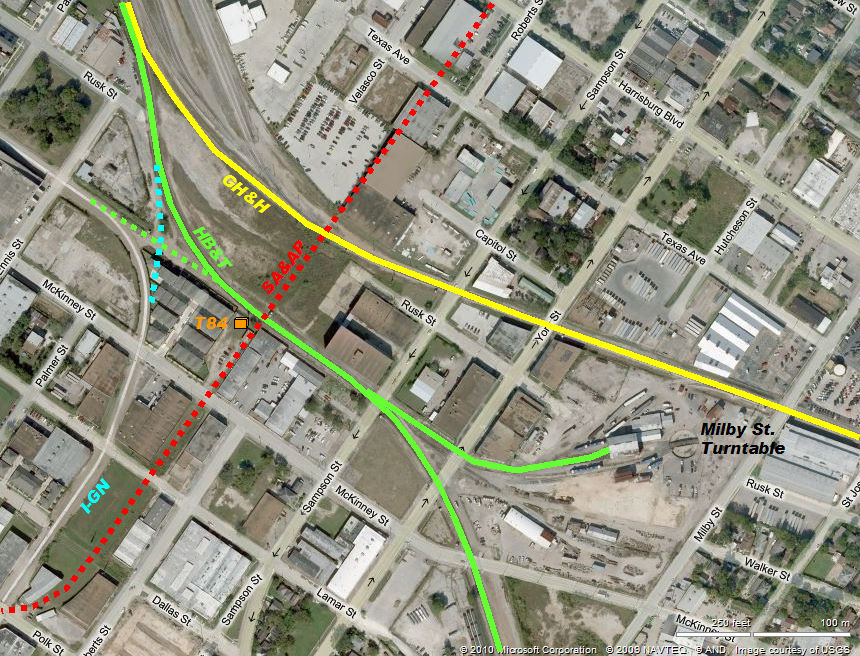
Above:
Only faint traces of the SA&AP remain. The I-GN curved sharply northwest as it neared
the HB&T (GC&SF) tracks, and the two railroads had a crisscross connection.
From the Sanborn map, it appears that GC&SF and I&GN originally shared the
right-of-way into downtown (and perhaps used the same tracks), and that the
HB&T route into downtown along the Galveston, Houston & Henderson (GH&H)
corridor was added later. The GH&H / SA&AP crossing was protected by stop signs,
not part of Tower 84's responsibilities. The initial construction of the Columbia
Tap Hike and Bike Trail in 2009 atop the I&GN right-of-way is also apparent in this
image.
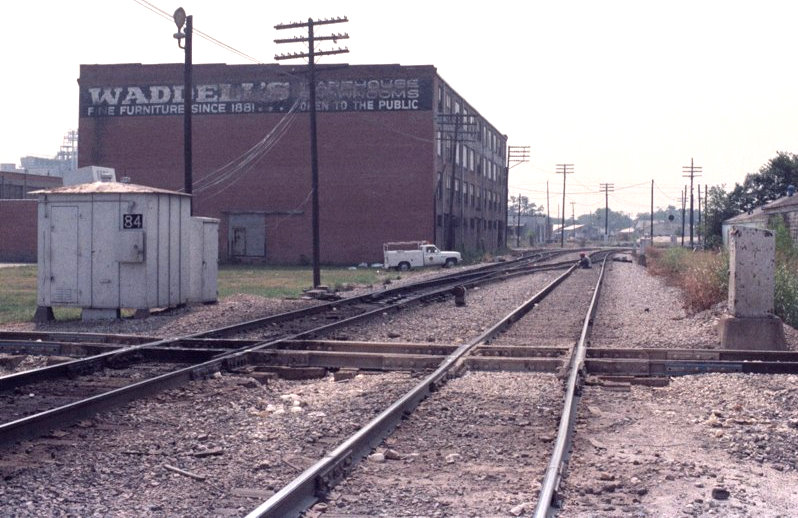
Above: Greg
Johnson provides this undated photo of a Tower 84 equipment cabinet, with the
former SA&AP rails crossing in the foreground. The view is east-southeast on
the HB&T. Below: A bird's eye view
(Microsoft Visual Earth) from roughly the same angle as above shows that
the SA&AP tracks are long
gone. The Waddell's Warehouse building remains, although the sign on the wall
has changed. In 2009, the
building was
designated as a historic structure by the City of Houston.
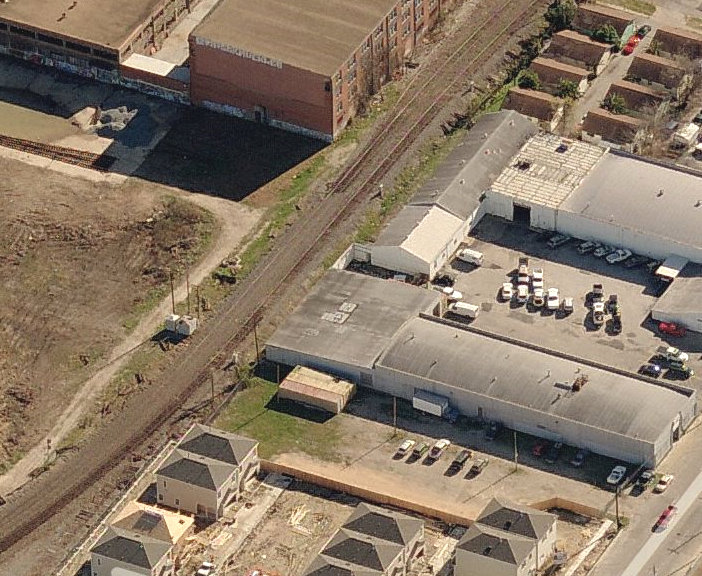
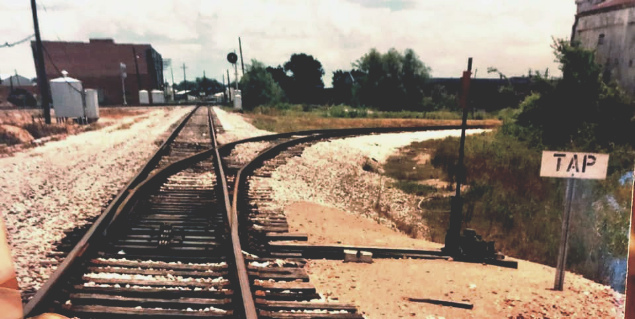
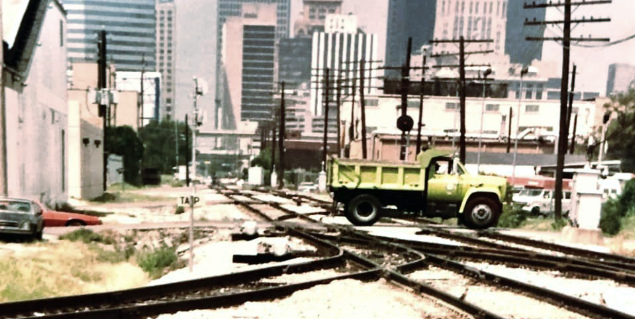
Above Left:
John Treadgold comments on his photo... "Here is where the Tap came off the
IGN/Mopac main near downtown Houston. Just up from Commerce yards near
Dowling and McKinney St. Photo just before it was abandoned and
eventually made into bike trail." Above Right:
John continues...
"This
is the same site looking West into Downtown Houston. Tap curves off this HBT
track to the South. This is full of townhouses and the tracks have been turned
into bike trail. Dynamo stadium would be straight ahead . 1980s"
Below: This 2014 Google Street
View image was taken from the Columbia Tap Trail looking east-southeast. The
brown structure in the background is the Waddell's Warehouse building. The light
rail tracks proceed onto the Columbia Tap right-of-way adjacent to the Trail,
but only for another block south to Lamar St. where the light rail tracks curve
to the east. Compare this image to Tom Kline's first photo below, taken in 2006.
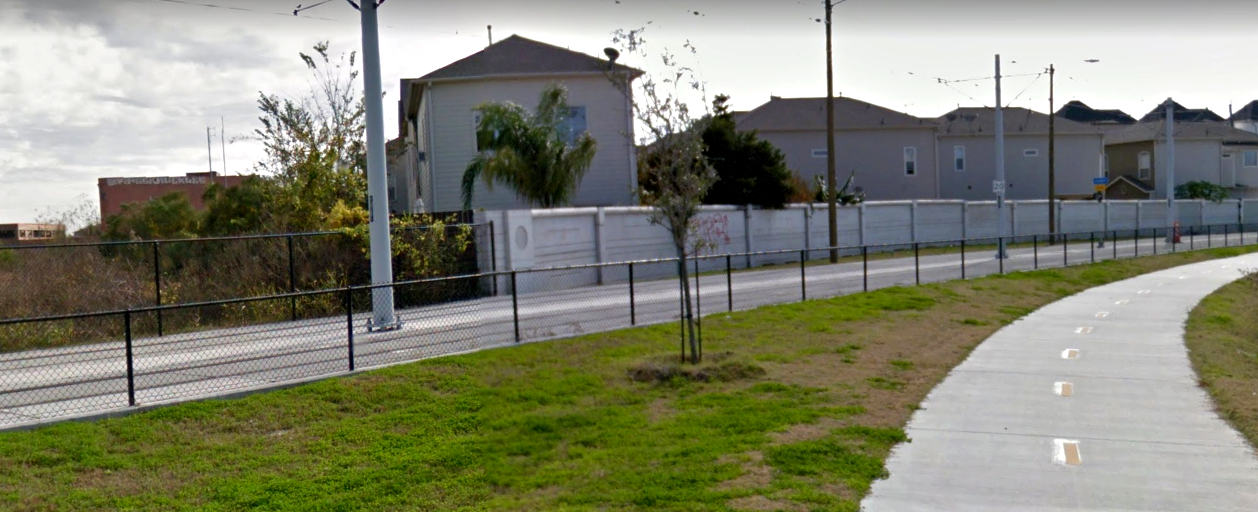
Tower 84 Site Photos from Tom Kline (Click to enlarge)

















